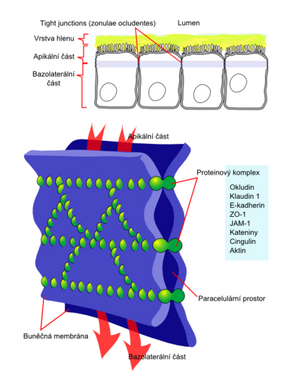Zonula Occludens
Characteristics[edit | edit source]
Zonula occludens (tight junction) is one of the specializations of the lateral walls of epithelial cells. It is a connection of cells in the form of a band that encircles the entire cell and encloses the intercellular spaces of the epithelium. This connection lies most apically and represents the closest cell connection.
The outer layers of adjacent cell membranes repeatedly merge with each other thanks to the transmembrane proteins claudin and occludin. Pictured from TEM resulting from the frost breaking technique, these connections can be observed as branching strips around each cell (a system of "furrows and combs"). The abundance of these strips is related to the permeability of the epithelium. For example, the epithelium of the proximal tubules kidney contains fewer fused sites (and is therefore more permeable) than the epithelium of the bladder.
Function[edit | edit source]
- Cell adhesions.
- Prevention of free penetration of substances through the epithelium (almost exclusively through cytoplasm).
- Blocks lateral diffusion of integral membrane proteins.
- Divides the cell surface into apical and basolateral surfaces. Integral membrane proteins from the apical surface cannot reach the basolateral surface and vice versa. Thus, both sides of the epithelium differ in their receptor and enzymatic equipment.
Links[edit | edit source]
Related Articles[edit | edit source]
Bibliography[edit | edit source]
- JUNQUEIRA, Luiz Carlos Uchôa – MESCHER, Anthony L. Junqueira's basic histology. 12. edition. 2010. 467 pp. ISBN 978-0-07-160431-4.
- KONRÁDOVÁ, Wenceslas, et al. Functional histology. 2. edition. H + H, 2000. 291 pp. ISBN 978-80-86022-80-2.
- Wikipedia: The Free Encyclopedia. Occludin [online]. The last revision 2011-01-23, [cit. 2011-03-07]. <https://en.wikipedia.org/wiki/Occludin>.


